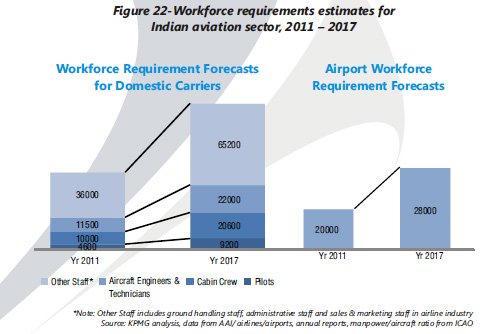According to a Ficci-KPMG report, India may become third largest aviation market 2020 and has the ability to become the world’s largest aviation hub by 2030.
Manpower requirement of the aviation sector in India is expected to grow nearly two-fold to 1.17 lakh by 2017 as carriers induct new aircrafts in the fleet, saysthe report.
“The total manpower requirement of airlines is estimated to rise from 62,000 in FY11 to 1,17,000 by FY17. This includes pilots, cabin crew, aircraft engineers and technicians (MRO), ground handling staff, cargo handling staff, administrative and sales staff,” a FICCI-KPMG report titled ‘Enhancing Air Connectivity’ released by Civil Aviation Secretary Ashok Lavasa said.
Besides, the aviation industry is believed to generate indirect and induced employment of nearly six times the direct employment, it said.
“With direct employment across airports and airlines to be around 1,50,000 by FY17, the domestic aviation sector is expected to provide an indirect and induced employment toaround 1 million people by FY17,” it said.
Noting that every additional job created in air transport results in creation of over six new jobs, the report said “the growth in the domestic aviation has created significant opportunities. With passengers and aircraft fleet likely to double by 2020, the need to strengthen the human resource development infrastructure is immediate.”
India, which is currently the ninth largest aviation market in the world with a fleet of over 400 aircrafts, is expected to acquire third position by 2020 with the fleet sizelikely to stand over 1,000 planes.
“The domestic aviation industry is on a high growth path. India has a vision of becoming the third largest aviation market by 2020 and the largest aviation market by 2030,” the report added.
The report predicts investments worth $50 billion over the next five years. By 2020, Indian carriers plan to increase fleet size to 800 aircrafts. In the next five years, 300 business jets, 300 small aircrafts and 250 helicopters are expected to be added to the current fleet.
The growth however has not been uniform, with certain northern and north eastern states lagging behind the southern and western states that house many of the country’s economic centers. However, the report expects this pattern to change as new centers of commercial activity emerge across the country.
With inputs from PTI
)